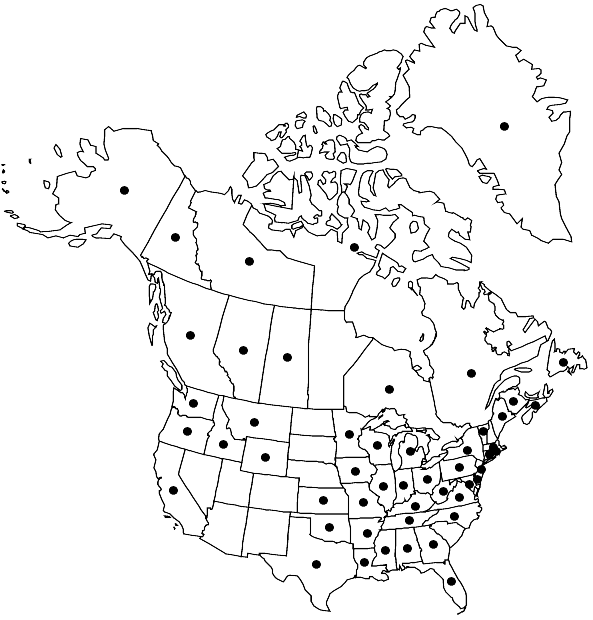Fissidens adianthoides
Sp. Musc. Frond., 157. 1801,.
Plants to 85 × 5 mm. Stem mostly branched; axillary hyaline nodules absent; central strand present. Leaves as many as 60 pairs, somewhat undulate, oblong to lanceolate, acute, occasionally obtuse, to 3.5 × 1.2 mm; dorsal lamina rounded or narrowed proximally, ending at insertion, not decurrent; vaginant laminae 1/2–3/5 the leaf length, ± equal, minor lamina ending on or near margin; margin crenulate to regularly serrulate but irregularly serrate distally, elimbate; costa ending 2–3 cells before apex to percurrent, taxifolius-type; laminal cells usually 1-stratose, infrequently and irregularly 2-stratose in the dorsal and ventral laminae, distinct, smooth, ± plane, firm-walled, irregularly quadrate to hexagonal, 10–20 µm, 1–5 marginal rows usually thinner with slightly thicker walls, forming a lighter marginal band, juxtacostal cells larger, mostly oblong and pellucid; vaginant laminal cells somewhat larger. Sexual condition dioicous (?); perigonia not seen; perichaetia on short axillary branches, generally confined to proximal half of stems. Sporophyte 1 per perichetium. Seta to 25 mm. Capsule theca mostly ± inclined, ± arcuate, bilaterally symmetric, to 1.5 mm; peristome taxifolius-type; operculum to 1.5 mm. Calyptra cucullate, smooth, to 2.5 mm. Spores 13–22 µm.
Habitat: Seepage areas, along streams, near waterfalls, meadows, soil, around bases of trees, decaying wood, dripping limestone and sandstone rocks and boulders
Distribution

Greenland, Alta., B.C., N.B., Nfld. and Labr. (Nfld.), N.W.T., N.S., Nunavut, Ont., Que., Sask., Yukon, Ala., Alaska, Ark., Calif., Conn., Del., Fla., Ga., Idaho, Ill., Ind., Iowa, Kans., Ky., La., Maine, Md., Mass., Mich., Minn., Miss., Mo., Mont., N.J., N.Y., N.C., Ohio, Okla., Oreg., Pa., R.I., Tenn., Tex., Vt., Va., Wash., W.Va., Wis., Wyo., Europe, Asia, Africa
Discussion
The usually 1-stratose, distinct, smooth, plane laminal cells, lighter band of marginal laminal cells, and short perichaetial stems in the axils of proximal leaves distinguish Fissidens adianthoides. The species, nevertheless, can be confused with F. osmundioides, which has similar laminal cells without a marginal band of lighter cells and a serrate leaf apex, but which differs in having terminal perichaetia and papillose rhizoids. Fissidens dubius, which also has short perichaetial stems in the axils of proximal leaves and often a lighter band of marginal laminal cells, differs from F. adianthoides in its smaller and rather obscure laminal cells that are consistently irregularly 2-stratose. Fissidens adianthoides and F. dubius (as F. cristatus), according to cytological evidence presented by L. E. Anderson and V. S. Bryan (1956), are distantly related.
Selected References
None.
Lower Taxa
No values specified."/2" is not declared as a valid unit of measurement for this property.